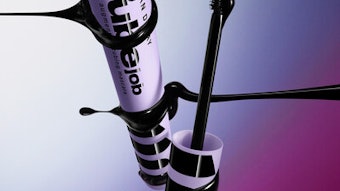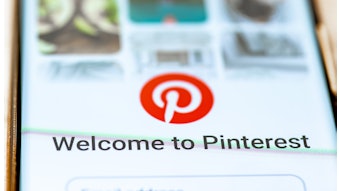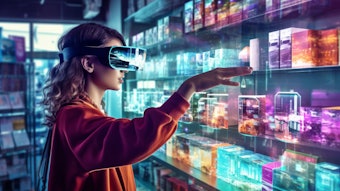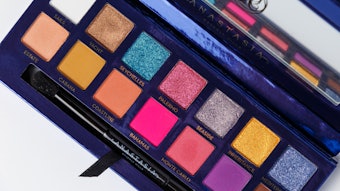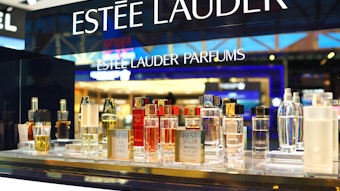As of the print date of the March 2010 issue, 2009 numbers were not available. That data is now available through Euromonitor International.
- The trend for bright, striking colors worn on the eyes has meant that consumers remained more open to experimenting with different eye products.
- The line between skin care and color cosmetics is becoming increasingly blurred.
- Brand domination of the color segment is changing, with an influx of budget products.
- Eastern Europe and Latin America should be high on the agenda of color brands.
- Lip products are booming in China, accounting for the majority of color cosmetics value sales: 52% in 2008.
- Due to the continuing social stigma surrounding male use of these typically female products, the Internet remains the prime channel for purchase in most other markets.
- A Halal standard, set for publication in summer 2010, should help to drive sales of cosmetics in devout Muslim countries, fostering color growth in the Middle East and Africa.
The credit crunch has not proved to be overly kind to sales of color cosmetics. Despite some still proclaiming the positive effects of the lipstick factor, the negative growth of most of the major beauty companies proves that the lipstick theory fell rather flat during the global recession this time around. Global growth in the segment slowed from 6% in 2007 to 4% in 2008* as consumers cut back on buying new products. To counteract consumer cuts in spending in the category, discounting, especially among mass brands, became rife in mature markets such as the U.S. and the U.K. This led to reductions in value sales.
Eye Color; Makeup Fairing Best
Eye color cosmetics and makeup (foundations and powders) both performed comparatively well, with eye products only dipping slightly in terms of growth to 6% in 2008 from 7% the previous year, according to Euromonitor International. The trend for bright, striking colors worn on the eyes has meant that consumers remained more open to experimenting with different eye products. Strong innovations in mascara also found no shortage of consumers willing to try these products out in the hope of achieving longer-looking lashes. Innovative products such as Lancôme’s Oscillation vibrating mascara and Givenchy’s Phenomen’Eyes mascara, complete with ball-shaped wand, have helped to maintain consumer interest in the segment.
Facial makeup managed to register 5% value growth in 2008 in Western Europe, one of the most mature and recession-hit regions. This success is largely linked to the concept of facial color cosmetics being an extension of skin care in the minds of many female consumers. With many foundations now promising sun protection and antiaging benefits, the line between skin care and color cosmetics is becoming increasingly blurred.
Furthermore, due to the fear of buying a foundation that does not match skin tone, many consumers refused to trade down to less expensive products and continued to opt for premium or masstige-priced products, many of which now automatically match skin tone.
Mature Markets See Rise in Private Label Sales
Color cosmetics sales were particularly hard hit in key mature markets such as the U.S. and the U.K., where consumers shunned department stores and the lure of premium beauty counters. In the U.S., for example, sluggish value growth of just over 0.5% in 2008 in color cosmetics had strong implications for global growth of the category because the U.S. alone accounts for a 20% share of global color cosmetic value sales.
Although private label has accounted for a significant share of toiletry sales for many years, commanding a 12% share of bath and shower products in Western Europe in 2008, for example, way above the share of any single brand, color cosmetics has traditionally been one of the few areas in beauty that has traditionally been dominated by brands. This is changing, however, and now the industry is suddenly seeing an influx of budget products. In the U.K. alone, there have been several high-profile launches of low-cost makeup ranges. Primark is one of the few retailers that has not only stayed afloat during the recession but also increased its company sales. The retailer has dabbled in the beauty market for some time, with shower gel and body lotion sales, but in summer 2009, it dipped its toes into the color cosmetics market. Its new range includes mascara, eye liners, lip gloss and eye shadows, many priced as low as £1.
Despite these prices being low enough to make consumers question the quality, it seems, for now, that price alone could be enough to persuade consumers to try the products. Whether or not they keep coming back is a different matter, but many more women are willing to take a chance on less expensive products for the time being.
Stagnant Growth in Mature Markets Offset by Emerging Regions
Stagnant sales of color cosmetics in mature regions were offset, to an extent, by double-digit growth in emerging markets such as Eastern Europe and Latin America. With 10% and 11% value growth, respectively, in 2008, these regions should be high on the agenda of color cosmetics players in the coming year.
China’s Outstanding Growth in Premium Color Cosmetics
China proved to be a bright spot for color cosmetics. The country’s rapidly rising disposable income levels, love affair with prestige brands and mistrust of local products meant that premium-priced makeup outperformed mass products in terms of value growth in 2008 (15% for the former and 13% for the latter). As a result, French beauty retailer Sephora has seen a meteoric rise in value sales and outlet numbers in just three years. In 2005, the retailer began its entry into China’s major cities, initially with just three stores. It now has 40, and plans to reach 100 by the end of 2010. As lipstick sales fell rather flat in many mature markets, lip products are booming in China, and accounted for 52%, or the majority of color cosmetics value sales in 2008. As color cosmetics are relatively new products for many Chinese women, especially those in rural areas and lower-tier cities, lipstick, which is the most basic product in overall color cosmetics, tends to be the first color cosmetic product for entry-stage female consumers living in these locations.
Russia’s Double-digit Performance
Although Russia was far from immune to the global recession, the color cosmetics segment in the country still proved to be a key contributor to global sales in the category, with value growth of 11% in 2008, only a slight drop from 12% in 2007.
As in the Chinese market, lip products are by far the most popular type of color cosmetics in Russia, accounting for 39% of total color cosmetic sales in 2008. Consumer loyalty in Russian color cosmetics is extremely low, with only around 5% of women sticking with a single brand. The majority use an average of five different brands, which has helped to keep sales in the segment high.
Premium facial makeup put in a strong performance in the country, with growth of 14% in 2008. This development was underpinned by new launches of multi-functional products such as Faberlic’s antiwrinkle Mineral Foundation and Giordani Gold Sublime’s foundation with sun protection. There has been a noticeable switch to premium brands as many female consumers perceive them to be of a superior quality to mass facial makeup.
Men Still Reluctant When It Comes to Color Cosmetics
There has been much hype around male-specific color cosmetics, with high-profile launches such as YSL Touche Éclat for Men, which is on sale across select countries in Western Europe. Outré fashion designer Jean Paul Gaultier first launched the premium-priced Le Male cosmetics range in October 2003, so the concept is nothing new. In Western markets, use is highest among younger males who are keen to emulate the “guyliner” look of rock stars such as Fall Out Boy’s Pete Wentz. Older generations remain almost totally averse to such products. Even men who are open to experimenting with male-specific color cosmetics are often only comfortable doing so when a product’s packaging looks masculine. The design of Touche Éclat for men highlights this need for men’s makeup to appear different to women’s in order to convince men to purchase it.
The case of the Japanese market shows that it is possible to achieve a high level of color cosmetics penetration among men. It is nothing unusual for men to wear color cosmetics in the country because the androgynous look is fashionable and strongly favored by young males. Male-only beauty stores such as the Dandy House in Tokyo, where men are given makeup tips and beauty treatments, are commonplace. However, Japan is atypical in its cultural acceptance of males purchasing color cosmetics. Due to the continuing social stigma surrounding male use of these typically female products, the Internet remains the prime channel for purchase in most other markets. Recognizing this, brands such as Clinique, with its M Cover concealer, have made sure their male-specific color cosmetic products are available to purchase online. This also allows brands more opportunities to inform and educate men about products. Despite talk of male cosmetics moving into the mainstream, male makeup is likely to remain largely confined to the Web.
Halal Could Be Key for Future Growth
The market for halal beauty products is currently in its infancy, but the development of a global standard for halal cosmetics is currently underway. International Halal Integrity Alliance (IHI Alliance) is currently working on the standard, which is set for publication in summer 2010 and should help to drive sales of cosmetics in devout Muslim countries. In 2008, female per capita spend on color cosmetics was just $21 per year in Saudi Arabia, compared with $57 in the U.S., despite the two countries having similar disposable income levels. A globally recognized standard should help to instill more consumer confidence when buying halal products, and develop the currently very low penetration of color cosmetics in the Middle East and Africa.
Shift in Long-term Global Beauty Growth Drivers
The new interest in budget makeup brands in developed markets means that the current change in focus from premium to masstige and mass cosmetics could be a long-term trend if private label products are deemed by women to perform well.
As luxury cosmetics players have to adjust to the new mind-set of lower spending in the West, emerging regions—the BRIC nations, in particular—will be an increasingly attractive focus for brand owners. Rising disposable income levels and resultant growing interest in color cosmetics in these markets will be key growth drivers for the industry through 2013. Brands that should perform best in the long-term will be those with the ability to connect with untapped consumer segments and countries.
Carrie Lennard is a research analyst at Euromonitor International.
